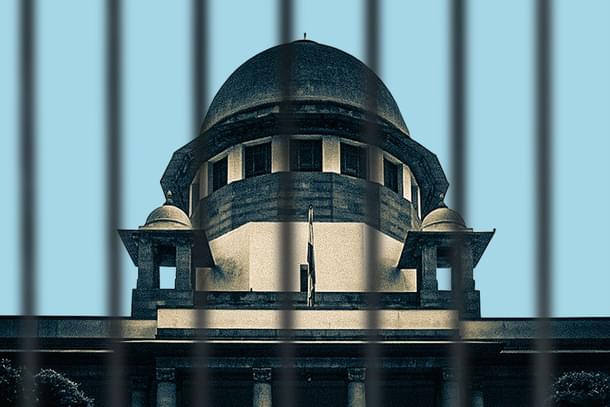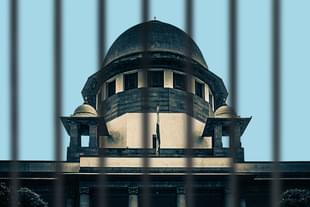Politics
SC’s Covid Meddling May Be A Violation Of Basic Features Doctrine And Damaging To Democracy
R Jagannathan
May 10, 2021, 11:39 AM | Updated 11:38 AM IST
Save & read from anywhere!
Bookmark stories for easy access on any device or the Swarajya app.


Once this Covid wave is behind us, though there are no early signs of that happening, we need to ask ourselves one big question: are our courts damaging democracy more than our politicians?
A corollary: are they not riding roughshod over the same 'basic features' judgement that a 13-judge constitutional bench verdict in the Kesavananda Bharati case in April 1973?
At the end of the day, the judiciary is not accountable for anything that goes wrong, but the executive and the legislatures are - to the people. But what we are seeing is increasing encroachment of the higher judiciary in executive domains. This cannot be in consonance with the 'basic features' doctrine that the courts have lived by since 1973.
The latest evidence of this is the Supreme Court’s decision to constitute a 12-member National Task Force on Covid response which will also work out a rational system of allocation of oxygen to hospitals and states.
That this came at the suggestion of the Centre’s own legal team only makes things worse: this is either abdication by the executive or an effort to save the Supreme Court itself some blushes for stomping on the existing oxygen allocation guidelines.
Without any audit or inherent competence to assess Delhi’s actual requirements, the court ordered the Centre to supply 700 tonnes of oxygen to Delhi, and refused to stay the Karnataka High Court order to supply 1,200 tonnes to that state.
The questions are: who will take the blame if things continue to go wrong on oxygen supplies? Certainly not the courts.
If Karnataka and Delhi are to be supplied what the High Courts ordered, is this going to come from supplies due to some other states? If all High Courts pass orders favouring their own states, how will the shortage be apportioned since the Supreme Court has already said Delhi should get a minimum of 700 tonnes and Karnataka 1,200 tonnes?
When it comes to disciplining its own side, the Supreme Court is pulling its own punches.
Last week, the apex court refused to pull up the Madras High Court for suggesting that the Election Commission could be charged with “murder” in oral questioning (it ultimately did not become an order), and the Allahabad High Court went ballistic and claimed that Uttar Pradesh’s failures on the Covid front were tantamount to “genocide”.
Genocide, really, when one can make a reasonable case for callousness and administrative failure?
By this token, maybe even the courts can be accused of allowing “slow genocide”, given the huge pendency of cases in both the lower courts and the higher judiciary. This is resulting in an agonising wait for millions of hapless litigants.
According to replies given by the Union Ministry of Law and Justice in Parliament last September, the total number of pending cases in all courts rose to 4 crore from 3.65 crore just seven months ago.
As on 1 May 2021, the Supreme Court had 67,898 cases in various stages of pendency, and various High Courts had 5.75 million cases pending with them.
No doubt, this is partly due to Covid, but if companies can work efficiently from home and keep things going, what stopped the judiciary from using technology (ie, more than it already has) to clear the backlog using the advantage of Covid, where physical hearings can be dispensed with, and written submissions and video conferencing could have speeded things up?
It’s an opportunity missed. If there was some higher authority than the courts, they would surely have been held to account.
Giving the judiciary a free pass and the right to make irresponsible comments against other constitutional bodies indicates that the highest court will hold everyone else responsible for their lapses except its own kind.
One can, of course, argue that given official bungling in oxygen allocations and Covid management, the courts have to step in to protect lives and rights. But did the US or UK courts intervene when their death tolls were rising dramatically all through (581,754 in the US and 127,865 in UK currently, which is several times India’s official count of 242,362 when adjusted for population)?
Why do only the Indian courts think they can do better than elected governments who will surely be worried more by the electoral impact of their incompetence? Did the BJP not lose elections in West Bengal for its own failures on Covid, among other things?
But even if we assume that the courts are beyond questioning in their own areas of operation, how is it acceptable that they should get into areas of governance. Isn’t this a breach of the “basic structure” of the constitutional scheme of things, as decided by the Supreme Court in the Kesavananda Bharati case of 1973?
In that case, the majority judgement prevented Parliament from amending some basic features of the Constitution even if it had the requisite majority. But basic features were left without a proper definition, since the same judgement said one fundamental right (the right to property) could be done away with, but said nothing about what the other basic features were beyond fundamental human rights.
Is the constitutionally-mandated separation of powers between the executive, legislature and courts not part of the inviolable basic feature which even the courts cannot trample upon at will?
If Parliament cannot do so, how can the courts themselves ride a coach and four over their own 13-judge verdict in the Kesavananda Bharati case?
Is this not an assault on democracy too?
Jagannathan is former Editorial Director, Swarajya. He tweets at @TheJaggi.




